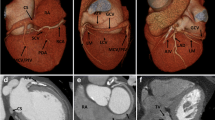Abstract
Sinus venosus defect (SVD) is an uncommon type of interatrial communication in which cardiac magnetic resonance (CMR) is increasingly used as an alternative imaging modality. The goal of this study was to determine the accuracy of CMR in patients with SVD compared with surgical findings. The diagnostic studies and operative reports of all patients who had CMR followed by surgical repair of SVD (n = 16) from 1996 to 2005 were reviewed and discrepancies were recorded. CMR studies included assessment of anatomy (evaluated by a combination of gradient echo cine, spin echo, and gadolinium-enhanced three-dimensional magnetic resonance angiography), ventricular volumes and function, and flow measurements. The median age at CMR was 14 years (range, 0.4–42). Compared with operative findings, there were no major discrepancies with CMR. The SVD was clearly imaged in all patients and 36 anomalously draining pulmonary veins were identified. The median pulmonary-to-systemic flow ratio was 2.4 (range, l.3–4.6). Patients had an average of 1.7 previous diagnostic tests (range, 1–3; 19 transthoracic echo, 5 catheterizations, and 3 transesophageal echo). Before CMR, SVD was diagnosed in 1 patient, suspected in 7, and not suspected in 8. Additional unsuspected findings identified by CMR included malposition of septum primum (n = 2), left superior vena cava to coronary sinus (n = 2), and aortic arch anomalies (n = 2). CMR accurately depicts SVD anatomy and associated anomalous pulmonary venous drainage, provides quantitative information on the hemodynamic burden, and reveals additional cardiovascular abnormalities. This experience indicates that CMR provides the information necessary for surgical planning of SVD repair.



Similar content being viewed by others
References
Alfakih K, Plein S, Thiele H, et al. (2003) Normal human left and right ventricular dimensions for MRI as assessed by turbo gradient echo and steady-state free precession imaging sequences. J Magn Reson Imaging 17:323–329
Beerbaum P, Korperich H, Esdorn H, et al. (2003) Atrial septal defects in pediatric patients: noninvasive sizing with cardiovascular MR imaging. Radiology 228:361–369
Edwards J (1953) Symposium on anomalous pulmonary venous connections (drainage): pathologic and developmental considerations in anomalous pulmonary venous connection. Pro Staff Mtgs Mayo Clinic 28:441–452
Ferrari VA, Scott CH, Holland GA, Axel L, Sutton MS (2001) Ultrafast three dimensional contrast-enhanced magnetic resonance angiography and imaging in the diagnosis of partial anomalous pulmonary venous drainage. J Am Coll Cardiol 37:1120–1128
Freed MD, Nadas AS, Norwood WI, Castaneda AR (1984) Is routine preoperative cardiac catheterization necessary before repair of secundum and sinus venosus atrial septal defects. J Am Coll Cardiol 4:333–336
Gnanapragasam JP, Houston AB, Northridge DB, Jamieson MP, Pollock JC (1991) Transoesophageal echocardiographic assessment of primum, secundum and sinus venosus atrial septal defects. Int J Cardiol 31(2):167–174
Greil GF, Powell AJ, Gildein HP, Geva T (2002) Gadolinium-enhanced three-dimensional magnetic resonance angiography of pulmonary and systemic venous anomalies. J Am Coll Cardiol 39:335–341
Kronzon I, Tunick PA, Freedberg RS, et al. (1991) Transesophageal echocardiography is superior to transthoracic echocardiography in the diagnosis of sinus venosus atrial septal defect. J Am Coll Cardiol:17:537–542
Moller JH, Nakib A, Andersona RC, Edwards JE (1967) Congenital cardiac disease associated with polysplenia. A developmental complex of bilateral “left-sidedness” Circulation 36:789–799
Muhler EG, Engelhardt W, von Bernuth G (1992) Detection of sinus venosus atrial septal defect by two-dimensional echocardiography. Eur Heart J 13:453–456
Pascoe RD, Oh JK, Warnes CA, et al. (1996) Diagnosis of sinus venosus atrial septal defect with transesophageal echocardiography. Circulation 94:1049–1055
Van Praagh S, Carrera ME, Sanders SP, Mayers JE, Van Praagh R (1994) Sinus venosus defects: unroofing of the right pulmonary veins—anatomic and echocardiographic findings and surgical treatment. Am Heart J 128:365–379
Acknowledgment
Dr. Valente was supported by a grant from the Children’s Miracle Network.
Author information
Authors and Affiliations
Corresponding author
Rights and permissions
About this article
Cite this article
Valente, A.M., Sena, L., Powell, A.J. et al. Cardiac Magnetic Resonance Imaging Evaluation of Sinus Venosus Defects. Pediatr Cardiol 28, 51–56 (2007). https://doi.org/10.1007/s00246-006-1477-y
Received:
Accepted:
Published:
Issue Date:
DOI: https://doi.org/10.1007/s00246-006-1477-y




